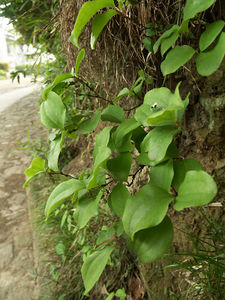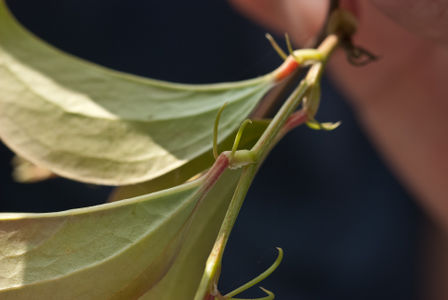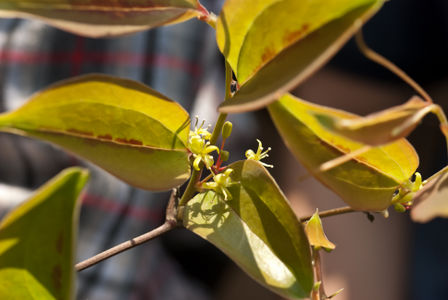Smilax china : Différence entre versions
(→Noms populaires) |
(→Histoire) |
||
| (15 révisions intermédiaires par 2 utilisateurs non affichées) | |||
| Ligne 9 : | Ligne 9 : | ||
|origine = Chine tempérée,<br>Taïwan, Japon, Corée, Philippines | |origine = Chine tempérée,<br>Taïwan, Japon, Corée, Philippines | ||
|statut = sauvage et cultivé | |statut = sauvage et cultivé | ||
| + | |français = '''squine''' | ||
| + | |anglais = '''China root''' | ||
| + | }}{{Encadré | ||
| + | |color=lightgreen | ||
| + | |titre=Résumé des usages | ||
| + | |texte=*rhizomes médicinaux, réputés contre la syphilis, et en Chine anticancéreux | ||
| + | *tiges utilisées comme liens aux Philippines | ||
| + | *jeunes pousses consommées en Thaïlande | ||
}} | }} | ||
| − | + | == Description == | |
| − | + | <gallery mode="packed"> | |
| − | + | Smilax china MC.tif|1, rhizome ; 2, partie de tige en fleurs ; 3, fleur mâle (PROSEA, Iskak Syamsudin) | |
| − | + | File:Sarutoriibara 08b2111.jpg|feuillage | |
| + | File:Smilax china 001.jpg|vrilles | ||
| + | File:Smilax china.jpg|fleurs | ||
| + | </gallery> | ||
*liane dioïque, ligneuse, ramifiée, atteignant 1-5 m de long | *liane dioïque, ligneuse, ramifiée, atteignant 1-5 m de long | ||
*vrilles présentes | *vrilles présentes | ||
| Ligne 20 : | Ligne 31 : | ||
*fleurs vert-jaunâtre | *fleurs vert-jaunâtre | ||
*fruits rouges, pruineux, globuleux, de 1-1,5 cm de diamètre | *fruits rouges, pruineux, globuleux, de 1-1,5 cm de diamètre | ||
| − | |||
| − | |||
| − | |||
| − | |||
| − | |||
| − | |||
== Noms populaires == | == Noms populaires == | ||
| − | + | {| class="wikitable" style="width:100%;" | |
| − | + | | français | |
| − | + | | racine de Chine, squine, esquine | |
| − | + | |- | |
| − | + | | anglais | |
| − | + | | China root, Chinese sarsaparilla | |
| − | + | |- | |
| − | + | | chinois | |
| + | | 菝葜 - ba qia (Flora of China) | ||
| + | |- | ||
| + | | hindi, bengali, marathi | ||
| + | | chob chini (Wealth of India) | ||
| + | |- | ||
| + | | Indonésie | ||
| + | | gadung cina (général), peundang (Aceh), ghadhung tambha (Madurais) (PROSEA) | ||
| + | |- | ||
| + | | Malaysia | ||
| + | | gadong china, gadong saberang, akar restong (PROSEA) | ||
| + | |- | ||
| + | | Philippines | ||
| + | | sarsaparillang-china (Tagalog), buanal (Igorot), palipit (Bontok) (PROSEA) | ||
| + | |- | ||
| + | | Vietnam | ||
| + | | kim chang trung quốe (PROSEA); tì giải, hay kim cang trung hoa (Wikipedia vi) | ||
| + | |} | ||
| − | + | *Voir l'étymologie de [[Dictionnaire étymologique#squine|squine]] | |
| − | + | *'''gadung cina''' signifie "igname de Chine". | |
| − | + | *D'après Ficalho, le hindi '''chob chini''' viendrait du persan '''چوب چينی - chūbi chīnī''' "bois de Chine" (Steingass) ; '''chūb''' viendrait du sanscrit '''kshupa'''... '''चोब - cob''' existe bien en hindi (Wagenaar), mais McGregor le fait venir du persan. Quoi qu'il en soit, les deux mots décalquent le portugais '''pau da China''', à moins que ce soit l'inverse. | |
| − | D'après Ficalho, le hindi chob chini viendrait du persan چوب چينی - chūbi chīnī "bois de Chine" (Steingass) ; chūb viendrait du sanscrit kshupa... चोब - cob existe bien en hindi (Wagenaar), mais McGregor le fait venir du persan. Quoi qu'il en soit, les deux mots décalquent le portugais pau da China, à moins que ce soit l'inverse. | + | |
| − | + | ||
| − | + | ||
| − | + | ||
| − | + | ||
| − | + | ||
| − | + | ||
| − | + | ||
== Classification == | == Classification == | ||
| Ligne 56 : | Ligne 70 : | ||
== Histoire == | == Histoire == | ||
La squine est arrivée en Occident au XVIe siècle, apportée par les Portugais et les Arabes. ''Wealth of India'' attribue également aux Portugais son introduction en Inde au même siècle. | La squine est arrivée en Occident au XVIe siècle, apportée par les Portugais et les Arabes. ''Wealth of India'' attribue également aux Portugais son introduction en Inde au même siècle. | ||
| + | |||
| + | [[Coloquio 47 (Garcia da Orta)|Garcia da Orta (colloque 47)]] est le premier botaniste à en parler en 1563 sous le nom de '''raiz da China''' ou '''páo da China'''. | ||
== Usages == | == Usages == | ||
| + | {{Citation encadré | ||
| + | |texte= In China and Japan cultivated since long times as medicinal plant. Also cultivated in India in house-gardens. The rhizomes are used for rheumatoid arthritis, gout, syphilis, skin disorders, enteritis and some kinds of cancer, also as an aphrodisiac. In the Philippines, the stems are used for tying and binding. Young stems and leaves of greenbrier have been reported to be eaten as vegetables in Thailand. Wild distribution: China, Korea, Japan, Philippines, NE India, North Vietnam. | ||
| + | |auteur =Mansfeld. | ||
| + | }} | ||
== Références == | == Références == | ||
| + | *Boym, Michał, 1696. ''Flora Sinensis''. Paris, 15 p. Seconde édition en français. Voir [[Flora Sinensis, 1696#Racine de la Chine|Racine de la Chine]] sur Pl@ntUse. | ||
*''Wealth of India (The),'' 1948-1976. ''A dictionary of Indian raw materials and industrial products''. New-Delhi, Council of scientific and industrial research. Vol. 9. ''Raw materials : Rh-So''. XXXVIII-472-XIV p. 1972. Reprinted 2005. | *''Wealth of India (The),'' 1948-1976. ''A dictionary of Indian raw materials and industrial products''. New-Delhi, Council of scientific and industrial research. Vol. 9. ''Raw materials : Rh-So''. XXXVIII-472-XIV p. 1972. Reprinted 2005. | ||
| Ligne 65 : | Ligne 86 : | ||
*[http://www.biodiversitylibrary.org/search.aspx?SearchTerm=Smilax%20china&SearchCat= BHL] | *[http://www.biodiversitylibrary.org/search.aspx?SearchTerm=Smilax%20china&SearchCat= BHL] | ||
*[http://www.efloras.org/florataxon.aspx?flora_id=2&taxon_id=200027905 Flora of China] | *[http://www.efloras.org/florataxon.aspx?flora_id=2&taxon_id=200027905 Flora of China] | ||
| + | *Grieve's herbal : [http://botanical.com/botanical/mgmh/c/china-63.html] et [http://botanical.com/botanical/mgmh/s/smilax55.html] | ||
*[http://www.ars-grin.gov/cgi-bin/npgs/html/tax_search.pl?Smilax%20china GRIN] | *[http://www.ars-grin.gov/cgi-bin/npgs/html/tax_search.pl?Smilax%20china GRIN] | ||
*[http://www.ipni.org/ipni/simplePlantNameSearch.do?find_wholeName=Smilax%20china&output_format=normal&query_type=by_query&back_page=query_ipni.html IPNI] | *[http://www.ipni.org/ipni/simplePlantNameSearch.do?find_wholeName=Smilax%20china&output_format=normal&query_type=by_query&back_page=query_ipni.html IPNI] | ||
| − | *[ | + | *[https://mansfeld.ipk-gatersleben.de/apex/f?p=185:46:9382014871325::NO::module,mf_use,source,akzanz,rehm,akzname,taxid:mf,,botnam,0,,Smilax%20china,6334 Mansfeld] |
*[http://www.theplantlist.org/tpl1.1/search?q=Smilax+china Plant List] | *[http://www.theplantlist.org/tpl1.1/search?q=Smilax+china Plant List] | ||
*[http://pfaf.org/user/Plant.aspx?LatinName=Smilax%20china Plants for a future] | *[http://pfaf.org/user/Plant.aspx?LatinName=Smilax%20china Plants for a future] | ||
| − | *[ | + | *[[:en:Smilax china (PROSEA)|PROSEA sur Pl@ntUse]] |
*[https://en.wikipedia.org/wiki/Smilax_china Wikipédia] (en) | *[https://en.wikipedia.org/wiki/Smilax_china Wikipédia] (en) | ||
Version actuelle en date du 11 juin 2023 à 22:03
Smilax china L.
| Ordre | Liliales |
|---|---|
| Famille | Smilacaceae |
| Genre | Smilax |
2n = 30, 90
Origine : Chine tempérée,
Taïwan, Japon, Corée, Philippines
sauvage et cultivé
| Français | squine |
|---|---|
| Anglais | China root |
- rhizomes médicinaux, réputés contre la syphilis, et en Chine anticancéreux
- tiges utilisées comme liens aux Philippines
- jeunes pousses consommées en Thaïlande
Sommaire
Description
- liane dioïque, ligneuse, ramifiée, atteignant 1-5 m de long
- vrilles présentes
- feuilles elliptiques à orbiculaires, de 3-10 cm de long
- ombelles de 10-25 fleurs
- fleurs vert-jaunâtre
- fruits rouges, pruineux, globuleux, de 1-1,5 cm de diamètre
Noms populaires
| français | racine de Chine, squine, esquine |
| anglais | China root, Chinese sarsaparilla |
| chinois | 菝葜 - ba qia (Flora of China) |
| hindi, bengali, marathi | chob chini (Wealth of India) |
| Indonésie | gadung cina (général), peundang (Aceh), ghadhung tambha (Madurais) (PROSEA) |
| Malaysia | gadong china, gadong saberang, akar restong (PROSEA) |
| Philippines | sarsaparillang-china (Tagalog), buanal (Igorot), palipit (Bontok) (PROSEA) |
| Vietnam | kim chang trung quốe (PROSEA); tì giải, hay kim cang trung hoa (Wikipedia vi) |
- Voir l'étymologie de squine
- gadung cina signifie "igname de Chine".
- D'après Ficalho, le hindi chob chini viendrait du persan چوب چينی - chūbi chīnī "bois de Chine" (Steingass) ; chūb viendrait du sanscrit kshupa... चोब - cob existe bien en hindi (Wagenaar), mais McGregor le fait venir du persan. Quoi qu'il en soit, les deux mots décalquent le portugais pau da China, à moins que ce soit l'inverse.
Classification
Smilax china L. (1753)
Cultivars
Histoire
La squine est arrivée en Occident au XVIe siècle, apportée par les Portugais et les Arabes. Wealth of India attribue également aux Portugais son introduction en Inde au même siècle.
Garcia da Orta (colloque 47) est le premier botaniste à en parler en 1563 sous le nom de raiz da China ou páo da China.
Usages
In China and Japan cultivated since long times as medicinal plant. Also cultivated in India in house-gardens. The rhizomes are used for rheumatoid arthritis, gout, syphilis, skin disorders, enteritis and some kinds of cancer, also as an aphrodisiac. In the Philippines, the stems are used for tying and binding. Young stems and leaves of greenbrier have been reported to be eaten as vegetables in Thailand. Wild distribution: China, Korea, Japan, Philippines, NE India, North Vietnam.
Références
- Boym, Michał, 1696. Flora Sinensis. Paris, 15 p. Seconde édition en français. Voir Racine de la Chine sur Pl@ntUse.
- Wealth of India (The), 1948-1976. A dictionary of Indian raw materials and industrial products. New-Delhi, Council of scientific and industrial research. Vol. 9. Raw materials : Rh-So. XXXVIII-472-XIV p. 1972. Reprinted 2005.
Liens
- BHL
- Flora of China
- Grieve's herbal : [1] et [2]
- GRIN
- IPNI
- Mansfeld
- Plant List
- Plants for a future
- PROSEA sur Pl@ntUse
- Wikipédia (en)


